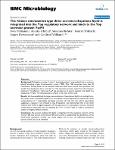The Yersinia enterocolitica type three secretion chaperone SycO is integrated into the Yop regulatory network and binds to the Yop secretion protein YscM1
Dittmann, Svea
Schmid, Annika
Richter, Susanna
Trülzsch, Konrad
Heesemann, Jürgen
Wilharm, Gottfried
Background: Pathogenic yersiniae (Y. pestis, Y. pseudotuberculosis, Y. enterocolitica) share a virulence plasmid encoding a type three secretion system (T3SS). This T3SS comprises more than 40 constituents. Among these are the transport substrates called Yops (Yersinia outer proteins), the specific Yop chaperones (Sycs), and the Ysc (Yop secretion) proteins which form the transport machinery. The effectors YopO and YopP are encoded on an operon together with SycO, the chaperone of YopO. The characterization of SycO is the focus of this study. Results: We have established the large-scale production of recombinant SycO in its outright form. We confirm that Y. enterocolitica SycO forms homodimers which is typical for Syc chaperones. SycO overproduction in Y. enterocolitica decreases secretion of Yops into the culture supernatant suggesting a regulatory role of SycO in type III secretion. We demonstrate that in vitro SycO interacts with YscM1, a negative regulator of Yop expression in Y. enterocolitica. However, the SycO overproduction phenotype was not mediated by YscM1, YscM2, YopO or YopP as revealed by analysis of isogenic deletion mutants. Conclusion: We present evidence that SycO is integrated into the regulatory network of the Yersinia T3SS. Our picture of the Yersinia T3SS interactome is supplemented by identification of the SycO/YscM1 interaction. Further, our results suggest that at least one additional interaction partner of SycO has to be identified.
Files in this item
No license information
Related Items
Show related Items with similar Title, Author, Creator or Subject.
-
2012-12-21ZeitschriftenartikelProtein-Protein Interaction Domains of Bacillus subtilis DivIVA Baarle, Suey van; Celik, Ilkay Nazli; Kaval, Karan Gautam; Bramkamp, Marc; Hamoen, Leendert W.; Halbedel, SvenDivIVA proteins are curvature-sensitive membrane binding proteins that recruit other proteins to the poles and the division septum. They consist of a conserved N-terminal lipid binding domain fused to a less conserved ...
-
2013-03-11ZeitschriftenartikelTowards further reduction and replacement of animal bioassays in prion research by cell and protein misfolding cyclic amplification assays Boerner, Susann; Wagenführ, Katja; Daus, Martin L.; Thomzig, Achim; Beekes, MichaelLaboratory animals have long since been used extensively in bioassays for prions in order to quantify, usually in terms of median infective doses [ID50], how infectious these pathogens are in vivo. The identification of ...
-
2013-08-08ZeitschriftenartikelCytomegalovirus Downregulates IRE1 to Repress the Unfolded Protein Response Stahl, Sebastian; Burkhart, Julia M.; Hinte, Florian; Tirosh, Boaz; Mohr, Hermine; Zahedi, René P.; Sickmann, Albert; Ruzsics, Zsolt; Budt, Matthias; Brune, WolframDuring viral infection, a massive demand for viral glycoproteins can overwhelm the capacity of the protein folding and quality control machinery, leading to an accumulation of unfolded proteins in the endoplasmic reticulum ...

